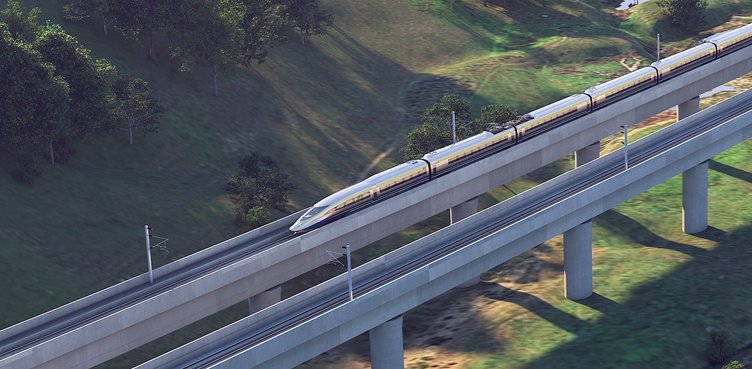The Sierra Club’s Loma Prieta Chapter is pressing the California High Speed Rail Authority to give a “robust” examination of sending trains over the Altamont Pass instead of simply declaring routing them over Pacheco Pass is the best alternative to connect Los Angeles to San Francisco.
The case to revive the previously rejected Altamont route that at one point was envisioned as a way to take trains from Merced to San Jose generally following the Union Pacific Railroad corridor and up through Ripon to Manteca where they would run down the 120 Bypass median was made in comments on the draft environmental impact report document for the San Jose to Merced segment.
Attorney Gary A. Patton outlined the Sierra Club chapter case in a June 3 letter. The Sierra Club Loma Prieta Chapter contends the Altamont Pass route is likely:
*To be less environmentally damaging to wildlife.
*Better protect agriculture.
*Not induce growth in relatively lightly urbanized areas such as Gilroy where the proposal for the Pacheco Pass segment calls for a station.
*Due to not having to build a 13.5-mile to burrow under Pacheco Pass that would require buried rail tubes through California’s most notorious earthquake fault — the San Andreas Fault — the Altamont Pass would be significantly less costly to build.
*To adhere to original ballot measure’s stated intent of penciling out operational costs as it would serve the urbanized Northern San Joaquin Valley Highway 99 corridor that continues to grow rapidly as the housing answer for the job-rich and housing tight Bay Area.
The Sierra Club chapter’s comments question whether the CHSRA actually ever gave serious consideration to analyzing the Altamont Pass option as being a viable alternative as required under California Environmental Quality Act and National Environment Policy Act.
Patton, in comments penned on behalf of the Sierra Club chapter, notes the state is violating its own CEQA laws as well as voter approved ballot language that got the high speed project rolling by analyzing the rail system that is being built in segments instead of what was the promised statewide system that ultimately would go from Sacramento to San Diego as well.
“By chopping up the integrated statewide project into discrete “segments” neither the Authority nor the public is able to evaluate possible alternatives in an intellectually or legally defensible,” the Sierra Club chapter attorney noted in his comments.
The biggest environmental damage would be to wildlife that depend on Coyote Valley in Santa Clara County for natural movements between the Santa Cruz Mountains and the Diablo Range. Among the wildlife that would be impacted are mountain lions, Tule elk, deer, coyotes and others.
The Sierra Club chapter notes wildlife would be significantly more impacted with the Pacheco Pass route as opposed to the Altamont Pass option.
The cost of the Pacheco Pass route, despite assertions by the CHSRA that the 54-mile segment from Chowchilla to Gilroy will only cost $5.6 billion to build was blown out of the water by observations made in 2018 by the world’s foremost tunnels experts including those that worked on the “Chunnel” connecting France and Great Britain. The experts contend the 13.5-mile tunnel crossing the highly active San Andreas Fault would cost at least $5.5 billion and possibly as high as $14 billion by itself.
“The cost projected for the Pacheco Pas alternate is huge,” Patton pointed out in comments on behalf of his client. “The other major alternative, the Altamont Pass route is likely to cost very significantly less — but, of course, an alternative analysis would be designed precisely to determine whether that is true, or not, and to what extent.”
The comments stress the Merced to Gilroy to San Jose segments doesn’t as effectively address transportation benefits promised in the 2008 ballot measure as a route across the Altamont Pass would. That’s because not only does the Altamont Pass corridor have more commuters — it is one of the most congested corridors in California — but growth caused by Bay Area development has been occurring and continues to occur along the Altamont corridor.
At one point ACE (Altamont Corridor Express) Forward segment from Ceres to Merced was looked at by CHSRA as a possible temporary way to get service to the Bay Area up and running before the Pacheco Pass segment comes online.
Such an alternate relied on the ACE plan to straighten out the tracks over the Altamont Pass to significantly pick up train speeds. That plan called for high speed train riders to switch to ACE trains in Merced until such time the Pacheco Pass route came online.
ACE trains are expected to start running as far south as Ceres by 2023 with stops also in Modesto, Ripon, and downtown Manteca.
The Altamont Pass option that the CSHRA rejected previously involved following the UP corridor up to Manteca and using a curving bridge structure to go above the 120 Bypass and then drop down to run down the freeway corridor to connect with ACE tracks west of Manteca.
Whether that route would be vetted again or altered somewhat would not be a point of discussion unless the Sierra Club chapter succeeds at resurrecting the alternative plan.
The original Altamont Pass plan did not call for a station between Merced and San Jose.
To contact Dennis Wyatt, email dwyatt@mantecabulletin.com





